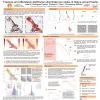Poster #187, SCEC Community Models (CXM)
Developing Web-based Visualization and Query Tools for the SCEC CVM, CFM, GFM, and CTM Community Models
Poster Image:

Poster Presentation
2020 SCEC Annual Meeting, Poster #187, SCEC Contribution #10315 VIEW PDF
CFM). The ultimate long-term goal of the CXM research group is to provide an internally consistent suite of models that can be used together to simulate deformation and seismic phenomena in southern California.
Over the past year, we have developed and refined several web-based graphical interfaces to the SCEC CXM models. The latest version of the CFM web viewer provides surface map and 3D views of CFM fault geometries and supports searches by name and region, with downloading of selected fault geometries in multiple formats and resolutions. We developed a prototype GFM/CTM web viewer that shows the geological and heat flow regions in southern California. Users can query these models and return geological region, lithology type, and temperature for user specified points. The prototype SCEC Community Velocity Model viewer has been extended into a more general SCEC Community Models Viewer (SCMV) that gives users options to view jointly subsets of the SCEC CVMs, CFM, GFM, and CTM models. The SCEC Community Models Viewer helps to show relationships and consistency between these models in ways not possible when viewing the models individually.
SHOW MORE
Over the past year, we have developed and refined several web-based graphical interfaces to the SCEC CXM models. The latest version of the CFM web viewer provides surface map and 3D views of CFM fault geometries and supports searches by name and region, with downloading of selected fault geometries in multiple formats and resolutions. We developed a prototype GFM/CTM web viewer that shows the geological and heat flow regions in southern California. Users can query these models and return geological region, lithology type, and temperature for user specified points. The prototype SCEC Community Velocity Model viewer has been extended into a more general SCEC Community Models Viewer (SCMV) that gives users options to view jointly subsets of the SCEC CVMs, CFM, GFM, and CTM models. The SCEC Community Models Viewer helps to show relationships and consistency between these models in ways not possible when viewing the models individually.
SHOW MORE





















































